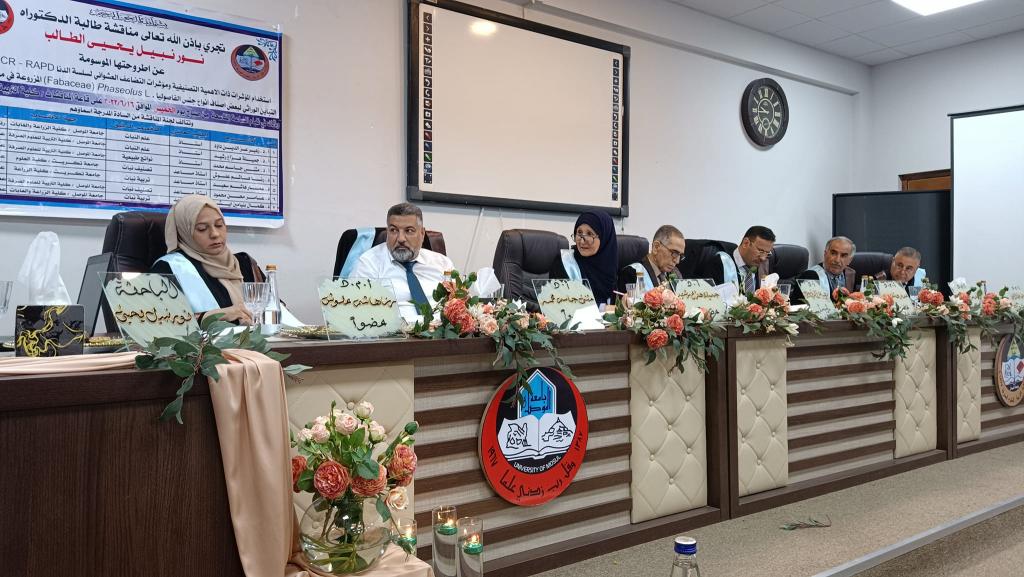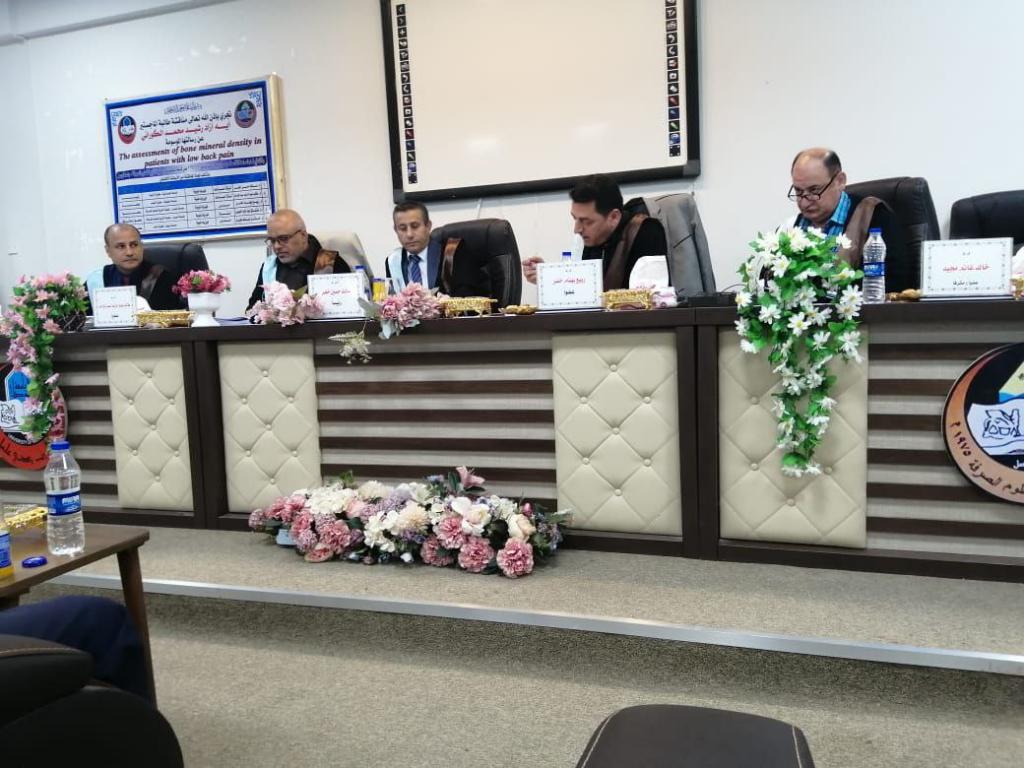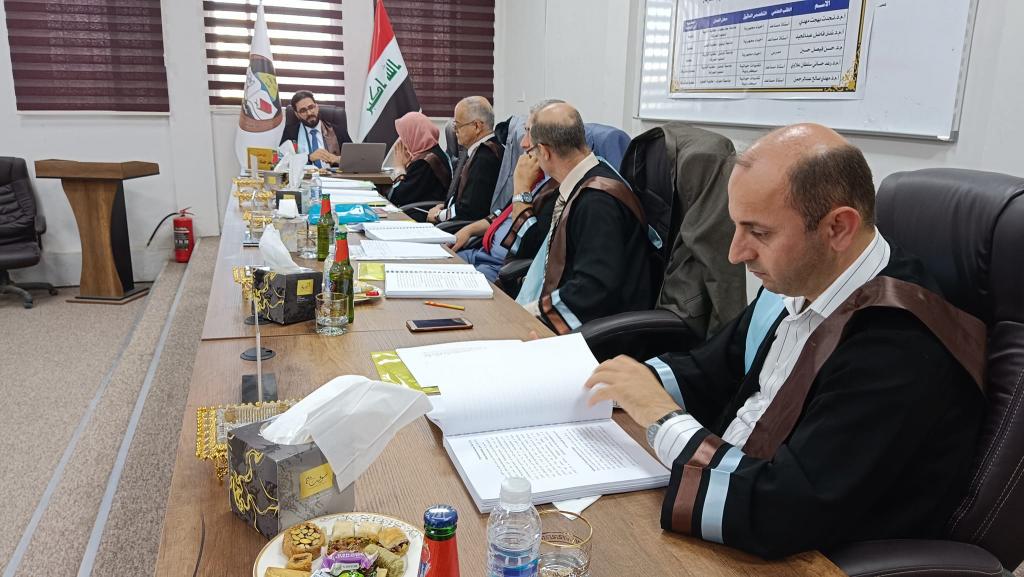16 June، 2022
PH.D. Dissertation Viva-Biology Department

PH.D. Dissertation Viva in the College of Education for Pure Science entitled “Use Important Taxonomic Characters and Random Amplification Polymorphic DNA for Determine Genetic Dimension of some Cultivars Species of the Genus Phaseouls L. (Fabaceae) Cultivated in Nineveh-Governorate”The College of Education for Pure Science, University of Mosul, has done the PH.D. Dissertation Viva entitled “Use Important Taxonomic Characters and Random Amplification Polymorphic DNA for Determine Genetic Dimension of some Cultivars Species of the Genus Phaseouls L. (Fabaceae) Cultivated in Nineveh-Governorate “,On Thursday, June 16, 2022, the College staff including the respected Dean of the College, Assistant Professor Dr. Qais Ismail Ibrahim, the Honorable Scientific Associate and Administrative Associate, the Honorable Head of the Department of Biology, and a number of the college’s teachers were attended the viva. This study, presented by the PH,D. student Noor Nabeel Yahaya Al-Talib in the Department of Biology, was included the use of indicators of taxonomic importance and indicators of random amplified polymorphic of DNA PCR-RAPD to determine the genetic distance of some cultivars species of the genus Phaseolus L. belong to the (Fabaceae) cultivated in Nineveh Governorate, which were represented by the cultivars (ʽBRS. Executiveʼ, ʽStrickʼ, Gii-867, ʽBrincoʼ, ʽDellareginaʼ) of the genus Phaseolus vulgaris and the cultivars (Brs- pitanjo, ʽTabascoʼ, Scraletrunner bean, ʽLima beansʼ) of the genus Phaseoluslanatus and the cultivars (ʽSiscresiatain paletaʼ, ʽMassornʼ, ʽFrascaʼ) of the Phaseolus coccinens.Through the dendrogram of the cultivars species of the genus Phaseolus L., it was found that they are divided into three main groups, namely: First main group This group included cultivars (ʽGii-867ʼ, ʽStrickʼ, ʽDellareginaʼ, Siscresiatian paleta, ʽLima beansʼ, ʽBrs-Pitanjoʼ, ʽFrascaʼ, Massaru, ʽBrincoʼ) This group was divided into two subgroups that included the first subgroup of taxa. (ʽFrascaʼ, Sis cresiatain, ʽBrs-Pitanjoʼ, ʽTabascoʼ, ʽMassornʼ, ʽLima beansʼ) and the genetic similarity ranged between (0.687- 0.883), and the second subgroup includes cultivars (ʽBrincoʼ, ʽStrrickʼ, Dellaregin). The similarity ranged between (0.766-0.873), the belonging of these cultivars to one group indicates a higher degree of similarity within the genetic material, which in turn is based on the number of joint bundles resulting from the indicators used in RAPD interactions, and the similarity was supported by morphological and anatomical studies in addition to the chemical study. Second main group this group contained the class ʽBRS. Executiveʼ of the type Phaseolus vulgaris, where it was not associated with the cultivars of the studied species except with a few sites of the RAPD, where it showed uniqueness in a number of sites and molecular sizes. Except for a few RAPD sites, it showed uniqueness in a number of sites and their molecular sizes. Which made it stay away from everyone as it was characterized by a distinctive pattern that differs clearly with the groups of other types of school. The Viva committee was chaired by Prof. Dr. Zuhair Ezz El-Din Daoud, University of Mosul, College of Agriculture and Forestry and the membership of Prof. Dr. Jamila Hazaa Rashid University of Mosul / College of Education for Pure Sciences, Prof. Dr. Muthanna Jassim Muhammad University of Mosul / College of Education for Pure Sciences, Assist Prof. Dr. Rana Hashem Alomash Tikrit University / College of Science, Assist Prof. Dr. Ammar Hashem Saeed, University of Tikrit / College of Agriculture and under the supervision and membership of both Assist. Prof. Dr. Amer Mohsen Mahmoud/ Mosul University/College of Education for Pure Sciences and Assist. Prof. Dr. Kamal B. Esho /University of Mosul/ College of Agriculture and Forestry.








